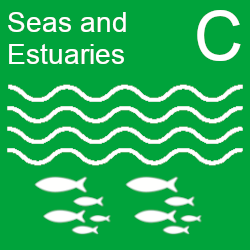Notice: From 01 December 2025, the Outcome Indicator Framework dashboard has been moved. Future updates to this publication are available on GOV.UK at: Environmental Indicator Framework.
Short Description
This indicator shows changes in the proportion of commercial fish and shellfish stocks that are within safe biological limits and fished sustainably. The indicator is derived from assessments of individual stocks. Where available, the assessment of stocks against their Maximum Sustainable Yield (MSY) will be incorporated into the overall indicator. The indicator is linked to UK Marine Strategy (UKMS) Descriptor 3 (Commercial Fish and Shellfish) and the Convention on Biological Diversity sustainable fisheries indicators and is derived from International Council for the Exploration of the Sea (ICES) and national stock assessments.
Readiness and links to data
An interim indicator is presented here that shows: C10a, the percentage of stocks of UK interest fished at or below the level capable of producing MSY (FMSY); and C10b, the percentage of stocks with Spawning Stock Biomass (SSB) at or above the level capable of producing MSY (MSY Btrigger).
The assessments used for this interim indicator have been reported under the UKMS Part One (2019) using data from 1990 to 2015 for FMSY and from 1990 to 2016 for MSY Btrigger. Data are also published annually in the form of other indicator UK Biodiversity Indicator B2 – Sustainable fisheries. Data on national shellfish stock assessments are not currently included in the interim C10 indicator but were published as part of the UKMS Part One (2019). Further updates will be made in the next update for UKMS Descriptor 3 and included in the final C10 indicator.
Notes on indicator
Indicator component C10a uses the same metrics as UKMS Descriptor 3.1 (commercial fish), showing the categories that can be assigned to a fish stock considering the reference point FMSY for fishing pressure that will provide the maximum sustainable yield in the long term. Stocks fished above FMSY are considered overfished and will deplete over time. In 2022, a fourth category was included in this indicator ‘percentage in FMSY range’ for few stocks managed under Multi Annual Plans for fisheries and fished above FMSY.
Indicator components
Figure C10a: Marine fish (quota) stocks of UK interest harvested sustainably, 1990 to 2020
Table C10a: Marine fish (quota) stocks of UK interest harvested sustainably, 1990 to 2020
| Year | Percentage sustainable (less than or equal to FMSY) | Percentage unsustainable in the long term (in FMSY range) | Percentage unsustainable (above FMSY) | Percentage unknown |
|---|---|---|---|---|
| 1990 | 8.77 | 1.75 | 40.35 | 49.12 |
| 1991 | 7.02 | 3.51 | 43.86 | 45.61 |
| 1992 | 10.53 | 1.75 | 43.86 | 43.86 |
| 1993 | 8.77 | 0.00 | 54.39 | 36.84 |
| 1994 | 10.53 | 1.75 | 52.63 | 35.09 |
| 1995 | 3.51 | 3.51 | 56.14 | 36.84 |
| 1996 | 5.26 | 3.51 | 57.90 | 33.33 |
| 1997 | 5.26 | 3.51 | 54.39 | 36.84 |
| 1998 | 3.51 | 3.51 | 59.65 | 33.33 |
| 1999 | 3.51 | 1.75 | 63.16 | 31.58 |
| 2000 | 5.26 | 3.51 | 59.65 | 31.58 |
| 2001 | 7.02 | 3.51 | 61.40 | 28.07 |
| 2002 | 12.28 | 5.26 | 54.39 | 28.07 |
| 2003 | 21.05 | 5.26 | 47.37 | 26.32 |
| 2004 | 17.54 | 5.26 | 49.12 | 28.07 |
| 2005 | 14.04 | 7.02 | 52.63 | 26.32 |
| 2006 | 14.04 | 8.77 | 50.88 | 26.32 |
| 2007 | 15.79 | 3.51 | 54.39 | 26.32 |
| 2008 | 14.04 | 3.51 | 56.14 | 26.32 |
| 2009 | 22.81 | 5.26 | 47.37 | 24.56 |
| 2010 | 26.32 | 5.26 | 42.10 | 26.32 |
| 2011 | 28.07 | 8.77 | 36.84 | 26.32 |
| 2012 | 33.33 | 5.26 | 36.84 | 24.56 |
| 2013 | 42.10 | 8.77 | 26.32 | 22.81 |
| 2014 | 36.84 | 8.77 | 31.58 | 22.81 |
| 2015 | 38.60 | 8.77 | 29.82 | 22.81 |
| 2016 | 38.60 | 12.28 | 26.32 | 22.81 |
| 2017 | 35.09 | 10.53 | 31.58 | 22.81 |
| 2018 | 42.10 | 10.53 | 24.56 | 22.81 |
| 2019 | 42.10 | 8.77 | 26.32 | 22.81 |
| 2020 | 49.12 | 7.02 | 21.05 | 22.81 |
Trend description for C10a
Overall, there is evidence of a positive trend towards a greater proportion of stocks fished sustainably in both the long term and in recent years. There is also a decreasing percentage of stocks with unknown status, from almost 50% in 1990 to 23% in 2020. The percentage of fish stocks (including Norway lobster, Nephrops norvegicus) fished at or below FMSY, and/or within acceptable mortality range levels, has increased from 10% in 1990 to 56% in 2020. The percentage fished above FMSY has decreased over the same time period, from 40% of UK quota-fish stocks assessed being fished at levels of fishing pressure above FMSY in 1990 to 21% in 2020.
Assessment of change
Assessments of change are made for the short term, as well as medium and long-term periods. In every case there has been an improvement recorded.
Change since 2018 has also been assessed, with an increase (improvement) in the percentage of quota fish stocks fished at less than or equal to FMSY detected. However, this is based on 3 data points so should be considered as indicative and not evidence of a clear trend.
The assessment results reported here are not directly comparable with other analyses published elsewhere that use different methodologies to explore these indicator components.
Further information on this assessment, along with details on the methodology, is provided in the Assessment background page. Summaries by 25 Year Environment Plan goal and information on indicator links are presented in the Assessment results pages.
Table C10a: Assessment of change
| Component | Subcomponent | Period | Date range | Percentage change | Smoothing function | Assessment of change |
|---|---|---|---|---|---|---|
| C10a | Percentage sustainable | Short term | 2015 to 2020 | 25.58 | Loess | Improvement |
| C10a | Percentage sustainable | Medium term | 2010 to 2020 | 81.59 | Loess | Improvement |
| C10a | Percentage sustainable | Long term | 1990 to 2020 | 355.55 | Loess | Improvement |
Note that assessment categories for the short, medium and long term were assigned based on smoothed data, so percentage change figures in Tables C10a may differ from unsmoothed values quoted elsewhere. Percentage change refers to the difference seen from the first to last year in the specified date range.
Figure C10b: Marine fish (quota) stocks of UK interest with biomass at levels capable of maintaining full reproductive capacity, 1990 to 2020
Table C10b: Marine fish (quota) stocks of UK interest with biomass at levels capable of maintaining full reproductive capacity, 1990 to 2020
| Year | Percentage sustainable (greater than or equal to MSY BTrigger) | Percentage risk of unsustainable (less than MSY BTrigger but greater than BLim) | Percentage unsustainable (less than MSY BTrigger and less than BLim) | Percentage unknown |
|---|---|---|---|---|
| 1990 | 28.07 | 15.79 | 10.53 | 45.61 |
| 1991 | 31.58 | 14.04 | 12.28 | 42.10 |
| 1992 | 35.09 | 14.04 | 10.53 | 40.35 |
| 1993 | 36.84 | 15.79 | 14.04 | 33.33 |
| 1994 | 42.10 | 15.79 | 10.53 | 31.58 |
| 1995 | 35.09 | 17.54 | 14.04 | 33.33 |
| 1996 | 36.84 | 22.81 | 10.53 | 29.82 |
| 1997 | 38.60 | 19.30 | 10.53 | 31.58 |
| 1998 | 45.61 | 15.79 | 10.53 | 28.07 |
| 1999 | 42.10 | 19.30 | 12.28 | 26.32 |
| 2000 | 36.84 | 22.81 | 14.04 | 26.32 |
| 2001 | 43.86 | 15.79 | 15.79 | 24.56 |
| 2002 | 43.86 | 14.04 | 17.54 | 24.56 |
| 2003 | 47.37 | 12.28 | 17.54 | 22.81 |
| 2004 | 40.35 | 21.05 | 15.79 | 22.81 |
| 2005 | 40.35 | 17.54 | 19.30 | 22.81 |
| 2006 | 40.35 | 17.54 | 19.30 | 22.81 |
| 2007 | 38.60 | 19.30 | 19.30 | 22.81 |
| 2008 | 45.61 | 17.54 | 15.79 | 21.05 |
| 2009 | 45.61 | 15.79 | 17.54 | 21.05 |
| 2010 | 52.63 | 10.53 | 15.79 | 21.05 |
| 2011 | 57.90 | 10.53 | 10.53 | 21.05 |
| 2012 | 54.39 | 8.77 | 15.79 | 21.05 |
| 2013 | 59.65 | 8.77 | 10.53 | 21.05 |
| 2014 | 57.90 | 5.26 | 15.79 | 21.05 |
| 2015 | 56.14 | 8.77 | 14.04 | 21.05 |
| 2016 | 56.14 | 10.53 | 12.28 | 21.05 |
| 2017 | 57.90 | 5.26 | 15.79 | 21.05 |
| 2018 | 57.90 | 7.02 | 14.04 | 21.05 |
| 2019 | 57.90 | 5.26 | 15.79 | 21.05 |
| 2020 | 57.90 | 3.51 | 15.79 | 22.81 |
Trend description for C10b
Overall, there is evidence of a positive trend for fish stocks remaining within safe biological limits in the long term, but little change in recent years. There is also a decreasing percentage of stocks with unknown status, from almost 46% in 1990 to 16% in 2020. To maintain the reproductive capacity of stocks, each SSB should be at or above the level capable of producing maximum sustainable yield (that is, MSY Btrigger). The percentage of stocks subject to quota management and achieving this goal has increased from 28% in 1990 to 58% in 2020.
Assessment of change
Assessments of change are made for the short term, as well as medium and long-term periods. In every case there has been an improvement recorded.
Change since 2018 has also been assessed. There was little or no change in marine fish stocks with biomass at levels capable of maintaining full reproductive capacity (that is, greater than or equal to MSY BTrigger). However, this is based on 3 data points so should be considered as indicative and not evidence of a clear trend.
The assessment results reported here are not directly comparable with other analyses published elsewhere that use different methodologies to explore these indicator components.
Further information on this assessment, along with details on the methodology, is provided in the Assessment background page. Summaries by 25 Year Environment Plan goal and information on indicator links are presented in the Assessment results pages.
Table C10b: Assessment of change
| Component | Subcomponent | Period | Date range | Percentage change | Smoothing function | Assessment of change |
|---|---|---|---|---|---|---|
| C10b | Percentage sustainable | Short term | 2015 to 2020 | 3.14 | Loess | Improvement |
| C10b | Percentage sustainable | Medium term | 2010 to 2020 | 17.26 | Loess | Improvement |
| C10b | Percentage sustainable | Long term | 1990 to 2020 | 93.66 | Loess | Improvement |
Note that assessment categories for the short, medium and long term were assigned based on smoothed data, so percentage change figures in Tables C10b may differ from unsmoothed values quoted elsewhere. Percentage change refers to the difference seen from the first to last year in the specified date range.

